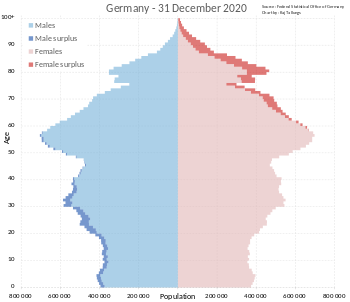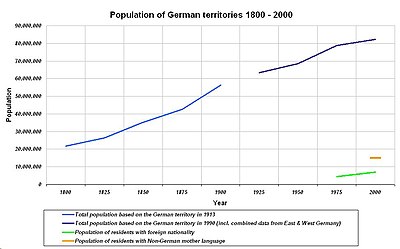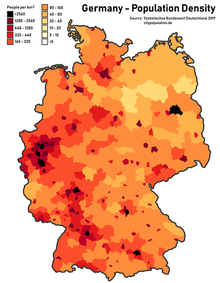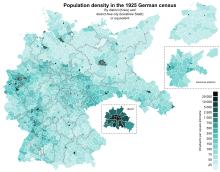| Demographics of Germany | |
|---|---|
 Population pyramid as of 31 December 2020 | |
| Population | |
| Growth rate | |
| Birth rate | |
| Death rate | |
| Life expectancy | |
| • male | |
| • female | |
| Fertility rate | |
| Infant mortality rate | |
| Sex ratio | |
| Total | 0.97 male(s)/female (2015) |
| At birth | 1.06 male(s)/female |
| Under 15 | 1.05 male(s)/female |
| 15–64 years | 1.02 male(s)/female |
| 65 and over | 0.76 male(s)/female |
| Nationality | |
| Nationality | noun: German(s) adjective: German |
| Major ethnic |
|
| Minor ethnic | |
| Language | |
| Official | German (77.05%) |
| Spoken | Turkish (2.53%) Russian (2.26%) Arabic (1.74%) Serbo-Croatian (1.28%) Polish (1.22%) English (1.20%) Romanian (0.91%) Ukrainian (0.72%) Albanian (0.71%) Kurdish (0.68%) Others (9.70%) |



| Year | Pop. | ±% p.a. |
|---|---|---|
| 1500 | 9,200,000 | — |
| 1550 | 12,900,000 | +0.68% |
| 1600 | 16,200,000 | +0.46% |
| 1650 | 10,000,000 | −0.96% |
| 1700 | 14,100,000 | +0.69% |
| 1750 | 18,300,000 | +0.52% |
| 1800 | 22,700,000 | +0.43% |
| 1850 | 35,303,000 | +0.89% |
| 1870 | 40,804,000 | +0.73% |
| 1900 | 56,046,000 | +1.06% |
| 1910 | 64,568,000 | +1.43% |
| 1920 | 61,974,000 | −0.41% |
| 1930 | 64,294,000 | +0.37% |
| 1940 | 69,838,000 | +0.83% |
| 1950 | 69,346,000 | −0.07% |
| 1960 | 73,147,000 | +0.54% |
| 1970 | 78,069,000 | +0.65% |
| 1980 | 78,397,000 | +0.04% |
| 1990 | 79,753,227 | +0.17% |
| 2000 | 82,259,540 | +0.31% |
| 2010 | 81,751,602 | −0.06% |
| 2020 | 83,155,031 | +0.17% |
| Source: DESTATIS (after 1950), Histat (1850−1940 Reich Boundaries),[4] Max Planck Society (1500−1840 Reich Boundaries (incl .Als.-Lor.))[5] | ||
The demography of Germany is monitored by the Statistisches Bundesamt (Federal Statistical Office of Germany). According to the most recent data, Germany's population is 84,669,326 (31 December 2023)[1] making it the most populous country in the European Union and the nineteenth-most populous country in the world. The total fertility rate was rated at 1.58 in 2021,[6] significantly below the replacement rate of 2.1. For a long time Germany had one of the world's lowest fertility rates of around 1.3 to 1.4, however there has been a small increase in recent years.[7] Due to the low birth rate Germany has recorded more deaths than births every year since 1972,[8] which means 2021 was the 50th consecutive year the German population would have decreased without immigration. However, due to immigration the population has actually increased during the last half-century. In 2019 the number of people with a foreign background was 26%;[9] this category includes foreigners, naturalized citizens, ethnic German repatriates from Eastern Europe and the children of all of the above.
Until the early 20th century Germany was also a large emigrant nation; in the 19th century more than 5 million citizens of the German Empire emigrated to the US alone, and in the early 20th century Germany lost another two million to the US as well as significant numbers to Latin America, Canada and Eastern Europe. However, after World War II immigration began to outweigh emigration, as around 14 million ethnic Germans were expelled from the former eastern provinces of the Reich and other areas in Eastern Europe. Of these, roughly 12 million made their way to present-day Germany and several hundred thousand settled in Austria and other countries, while several hundred thousand died. Some additional 4.5 million ethnic Germans from Eastern Europe repatriated after 1950, especially around the end of the Eastern Bloc and mostly from the former Soviet Union, Poland and Romania.[10][11]
Large-scale immigration to West Germany began during the time of the Wirtschaftswunder from the 1950s to early 1970s when Germany had a shortage of workers and let in Southern Europeans from countries like Turkey, Italy and Spain on a temporary basis as guest workers. The liberalisation of guest worker legislation allowed many to stay and build a life in West Germany. Germany saw another large wave of immigration towards the end of the 20th century, driven by German reunification, refugee inflows from the Yugoslav Wars and large numbers of Turkish nationals seeking asylum. The next large immigration wave began after eastern expansion of the European Union in 2011 as Eastern Europeans were now allowed to live and work in Germany without a visa. During the European migrant crisis of 2015 Germany took in a large number of refugees, both in absolute terms and relative to other EU member states; the country recorded 476,649 asylum seekers in 2015, 745,545 in 2016 and declining numbers thereafter.[12]
Germany has one of the world's highest levels of education, technological development, and economic productivity. Since the end of World War II, the number of students entering university has more than tripled, and the trade and technical schools are among the world's best. With a per capita income of about €40,883 in 2018,[13] Germany is a broadly middle-class society. However, there has been a strong increase in the number of children living in poverty. In 1965, one in 75 children was on the welfare rolls; but by 2007 this had increased to one child in six. These children live in relative poverty, but not necessarily in absolute poverty.[14] Millions of Germans travel overseas each year. The social welfare system provides for universal health care, unemployment compensation, child benefits and other social programmes. Germany's aging population and struggling economy strained the welfare system in the 1990s, so the government adopted a wide-ranging programme of – still controversial – belt-tightening reforms, Agenda 2010, including the labour-market reforms known as Hartz concept.
- ^ a b "Bevölkerungsstand". Archived from the original on 23 August 2019. Retrieved 4 January 2022.
- ^ a b "Lebendgeborene und Gestorbene". Retrieved 13 September 2019.
- ^ "Lebenserwartung in Deutschland nahezu unverändert". Retrieved 9 July 2021.
- ^ "Histat:Population statistics". Retrieved 31 August 2021.[permanent dead link]
- ^ "The Population History of Germany: Research Strategy and Preliminary Results" (PDF). Archived (PDF) from the original on 23 December 2010.
- ^ "Zusammengefasste Geburtenziffer nach Kalenderjahren". Retrieved 13 September 2019.
- ^ "Die Datenbank des Statistischen Bundesamtes". Retrieved 1 July 2021.
- ^ "Births and Deaths". Retrieved 1 July 2021.
- ^ "Migrant background". Retrieved 1 July 2021.
- ^ "Bund der Vertriebenen: Aktuelle Aussiedlerstatistik". www.bund-der-vertriebenen.de. Retrieved 26 May 2022.
- ^ "Russia Hopes to Lure Back Ethnic Germans". DW.
- ^ "Asylum statistics". Archived from the original on 9 July 2021. Retrieved 2 July 2021.
- ^ "Important Economic Indicators". 15 January 2019.
- ^ "Sozialhilfe: Kinderarmut nimmt zu". Focus. 15 November 2007